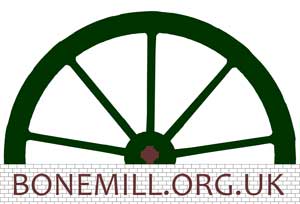On Saturday 3rd October 2015 we attempted to turn the wheel by raising the river level enough to flood the upstream brick floor and allow water to flow below the metal plate. When the mill was working the river level would have been much higher and would have fed the wheel from above the metal plate giving the increased power needed to operate the millstones and machinery. It was not known whether the wheel would rotate by feeding under the plate, but it was not practical to raise the river to the original level.
At The Maltings, scaffold boards had been nailed together to make interlocking boards for slotting into the original sluice slots, these were loaded onto the trailer along with tools for removing them afterwards and a chainsaw for trimming them to size. Foam boards and geotextile sheets were also loaded up for protection of the site over winter.
The tractor and trailer led the convoy of family and volunteers to site. A table was set up for cakes and drinks ready for a celebration if the wheel turned. The water wheel bearings were oiled and the wheel was turned manually to ensure it was not at a tight spot to give the best chance of moving under water power. A plank was put across the piers to give easy access to the sluice. Scaffolding from the brickwork was still in place which gave a working platform in the river. The first board was put in the sluice and the river rose rapidly and soon a thick weir of water was flowing over the top. The downstream side of the river took longer to recover and a small fish was stranded in the low water which was rescued. When the level recovered the next plank was put in place, then after a while the third was added.
The first boards were bowing under water pressure, when the next board was added there was a gap which allowed water to escape, giving a longer wait for the level to build up. Gaps between the boards were filled with weeds and pieces of wood to block the worst leaks. The water rose slowly and eventually started to cover the step at the start of the brick floor. We wondered if one more board would be enough as we could see the water needed to rise above the first step, then the brick lip near the wheel, then a slope up before it would flow over and into the wheel. The last purpose made board was put in place and was not quite enough to give the height needed, so the board used as a bridge across the piers was trimmed to size with the chainsaw and put in the sluice. The weir was leaking badly now, the top board was thinner and bowed under pressure so there was a large escape of water but eventually it flowed over the slope and reached the wheel. This small flow was escaping under the wheel losing more water, so a shorter board was used to hold back the supply of water into the wheel, to be released when the level built up.
While the board was being held in place the wheel suddenly turned a small amount, so the board was removed, the wheel then turned almost a full revolution before stopping at the tight spot, then the paddles fully filled up with water and started the process again. Eventually when it came to the tight spot it would slow down instead of stopping. More oil was put on the bearings and we realised what we thought was a tight spot was actually an out of balance due to the new replacement steel paddles on one side being lighter than the original paddles which had accumulated debris. With the wheel now turning continuously, the lovely cakes were eaten in celebration and it was agreed to get the wheel turning again now we know it can be done. After all the work of applying for the HLF grant, organising contractors, carrying out the physical work on site and all the other obstacles and behind-the-scenes effort, it was agreed it was all worth it to see the wheel turning under water power.
Interactive Plan Gate Frame Blog 8/10/15 Water Feed Pipe GoPro Video



